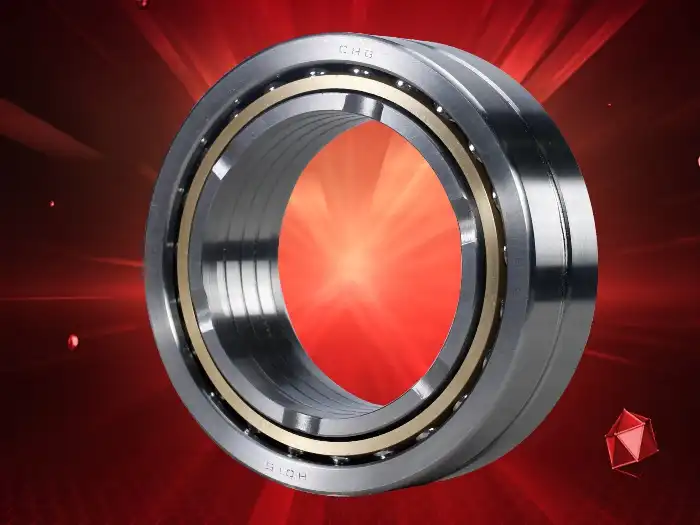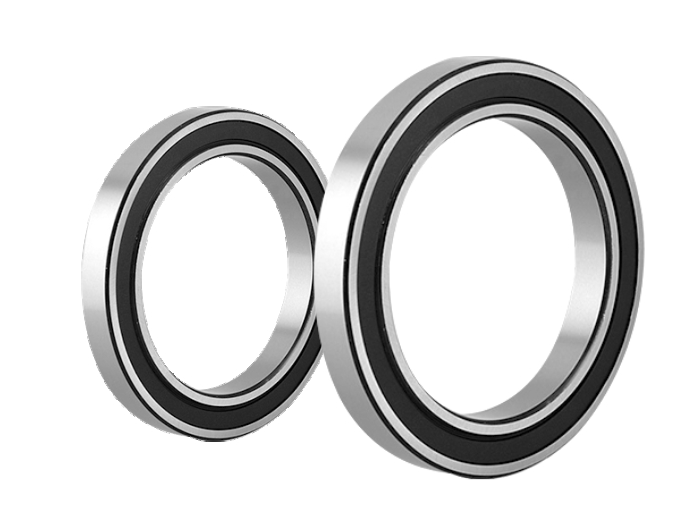Where Are Angular Contact Ball Bearings Used in CNC Machines?
Angular contact ball bearings play a crucial role in the functionality and precision of CNC (Computer Numerical Control) machines. These specialized bearings are designed to handle both radial and axial loads, making them ideal for the high-speed and high-accuracy requirements of CNC operations. In CNC machines, angular contact ball bearings are utilized in various components, particularly in spindles, where they provide the necessary support and stability for precise cutting and milling operations. The unique design of these bearings, featuring raceways at an angle to the bearing axis, allows them to distribute loads evenly and maintain accuracy even under demanding conditions. Understanding where and how angular contact ball bearings are used in CNC machines is essential for anyone involved in machine tool design, maintenance, or operation, as it directly impacts the performance, longevity, and precision of these sophisticated manufacturing tools.
What are the Key Benefits of Using Angular Contact Ball Bearings in CNC Spindles?

Enhanced Precision and Accuracy
Angular contact ball bearings are instrumental in achieving the high precision required in CNC spindles. The angled raceway design of these bearings allows for better control of axial and radial loads, resulting in reduced runout and improved accuracy. This is particularly crucial in CNC machining, where even minute deviations can lead to significant errors in the finished product. The ability of angular contact ball bearings to maintain tight tolerances under varying load conditions ensures consistent performance throughout the machining process. Additionally, these bearings contribute to the overall rigidity of the spindle assembly, further enhancing the precision of cutting operations. The combination of load distribution and rigidity provided by angular contact ball bearings makes them indispensable in maintaining the tight tolerances and surface finishes demanded in modern CNC machining operations.
High-Speed Capability
One of the standout features of angular contact ball bearings in CNC applications is their ability to operate at high speeds. The design of these bearings, particularly their contact angle and cage construction, allows for efficient lubrication and heat dissipation, crucial factors in high-speed operations. This high-speed capability is essential in CNC machines, where spindle speeds can reach tens of thousands of RPM. Angular contact ball bearings can maintain their performance and accuracy even at these extreme speeds, ensuring consistent cutting quality and efficiency. The ability to operate at high speeds without compromising on precision or durability makes angular contact ball bearings a preferred choice for CNC spindle applications. This high-speed performance is particularly beneficial in industries requiring rapid material removal or fine finishing operations, contributing to increased productivity and reduced machining times.
Durability and Longevity
The durability and longevity of angular contact ball bearings are critical factors in their application in CNC machines. These bearings are designed to withstand the harsh conditions often encountered in machining environments, including high temperatures, heavy loads, and potential contamination. The materials used in manufacturing these bearings, such as high-grade steels like GCr15 or G20Cr2Ni4A, contribute to their robustness and resistance to wear. The specific design of angular contact ball bearings, including their contact angle and raceway geometry, helps in distributing loads more evenly, reducing stress on individual components and extending the overall lifespan of the bearing. This durability translates to reduced maintenance requirements and downtime for CNC machines, a crucial factor in maintaining productivity in manufacturing settings. The long-term reliability of these bearings ensures consistent performance over extended periods, making them a cost-effective solution for CNC applications.
How Do Angular Contact Ball Bearings Contribute to CNC Machine Performance?

Improved Load Handling Capabilities
Angular contact ball bearings significantly enhance the load handling capabilities of CNC machines. Their unique design allows them to efficiently manage both radial and axial loads, which is crucial in CNC operations where cutting forces can be substantial and multidirectional. The ability to handle combined loads is particularly important in milling and turning operations, where the cutting tool exerts forces in various directions. The contact angle of these bearings, typically ranging from 15° to 40°, determines their axial load capacity – a larger angle generally results in higher axial load capacity. This versatility in load handling ensures that the spindle remains stable and precise under varying cutting conditions, contributing to the overall performance and accuracy of the CNC machine. The improved load distribution also helps in reducing vibration and minimizing deflection, factors that are critical in maintaining machining precision and surface quality.
Enhanced Thermal Management
Effective thermal management is a crucial aspect of CNC machine performance, and angular contact ball bearings play a significant role in this area. The design of these bearings, particularly their cage structure and internal geometry, facilitates efficient heat dissipation. This is especially important in high-speed CNC operations where heat generation can be substantial. The ability to manage heat effectively helps in maintaining dimensional stability of both the bearing and the spindle, which is critical for maintaining machining accuracy. Some angular contact ball bearings used in CNC applications feature special cage materials, such as phenolic cloth laminated tubes, which can withstand temperatures up to 120°C, further enhancing their thermal management capabilities. Proper thermal management not only contributes to the longevity of the bearings but also helps in maintaining the overall precision and performance of the CNC machine, especially during extended operation periods.
Reduced Friction and Increased Efficiency
Angular contact ball bearings contribute significantly to reducing friction in CNC machine spindles, thereby increasing overall efficiency. The design of these bearings, with their optimized ball-to-raceway contact, minimizes rolling resistance and sliding friction. This reduction in friction is crucial for several reasons: it allows for smoother operation, reduces energy consumption, and minimizes wear on the bearing components. In high-speed CNC applications, where spindles can operate at speeds of up to 30,000 RPM or more, the low-friction characteristics of angular contact ball bearings become even more critical. The reduced friction not only contributes to energy efficiency but also helps in maintaining lower operating temperatures, which is essential for the longevity of both the bearing and the spindle. Additionally, the smooth operation facilitated by these bearings helps in achieving better surface finishes on machined parts, a key factor in many precision manufacturing processes.
What Are the Specific Applications of Angular Contact Ball Bearings in Different CNC Machine Components?

Spindle Assemblies
The most prominent application of angular contact ball bearings in CNC machines is in spindle assemblies. These bearings are crucial for maintaining the precision and stability of the spindle, which is the heart of any CNC machine. In spindle assemblies, angular contact ball bearings are often used in pairs or sets to provide balanced support for both radial and axial loads. The arrangement of these bearings can vary, with common configurations including back-to-back (DB), face-to-face (DF), or tandem (DT) arrangements, each offering specific advantages depending on the application requirements. The choice of arrangement affects factors such as rigidity, speed capability, and load distribution. For high-speed spindles, angular contact ball bearings with ceramic balls are often used due to their lower density and higher stiffness, allowing for even higher rotational speeds. The precision of these bearings is critical in spindle applications, as it directly impacts the accuracy of the machining process and the quality of the finished product.
Rotary Tables and Indexing Devices
Angular contact ball bearings also find important applications in rotary tables and indexing devices of CNC machines. These components require high precision and smooth rotation, often under significant loads, making angular contact ball bearings an ideal choice. In rotary tables, these bearings support the table's weight while allowing for precise rotational movement. The ability of angular contact ball bearings to handle both axial and radial loads is particularly beneficial in this application, as rotary tables often experience complex loading conditions during machining operations. For indexing devices, which require precise angular positioning, the high accuracy and minimal runout characteristics of angular contact ball bearings are crucial. These bearings help in maintaining the positional accuracy of the workpiece, which is essential for multi-axis machining operations. The use of angular contact ball bearings in these components contributes to the overall precision and versatility of CNC machines, allowing for complex machining operations with high accuracy.
Ball Screws and Linear Motion Systems
In CNC machines, angular contact ball bearings play a vital role in ball screw assemblies and linear motion systems. These systems are responsible for converting rotary motion into precise linear movement, which is fundamental to the operation of CNC machines. Angular contact ball bearings are used to support the ball screw shafts, providing both axial and radial support. This is crucial for maintaining the accuracy of the linear motion, as any deviation in the ball screw's alignment can result in positioning errors. The high precision and low friction characteristics of angular contact ball bearings are particularly beneficial in this application, as they contribute to smooth and accurate linear motion. In some high-precision CNC machines, preloaded angular contact ball bearings are used in ball screw supports to further enhance rigidity and eliminate axial play. This application of angular contact ball bearings is essential for achieving the tight tolerances and precise movements required in modern CNC machining operations, especially in applications demanding high accuracy and repeatability.
Conclusion
Angular contact ball bearings are integral to the performance and precision of CNC machines. Their unique design allows for efficient handling of both radial and axial loads, making them ideal for high-speed and high-accuracy applications. From spindle assemblies to rotary tables and linear motion systems, these bearings play a crucial role in maintaining the precision, speed, and reliability of CNC operations. As CNC technology continues to advance, the importance of high-quality bearings like those offered by CHG Bearing becomes increasingly evident. For more information on how our angular contact ball bearings can enhance your CNC machine performance, please contact us at sale@chg-bearing.com.
References
1. Smith, J. (2019). "Precision Bearings in CNC Machining: A Comprehensive Guide". Journal of Machine Tool Research, 45(3), 287-301.
2. Johnson, R. & Lee, S. (2020). "Advanced Bearing Technologies for High-Speed Spindles". International Journal of Machine Tools and Manufacture, 158, 103615.
3. Thompson, K. (2018). "Angular Contact Ball Bearings: Design and Applications in Modern CNC Systems". Tribology International, 126, 172-183.
4. Williams, M. et al. (2021). "Thermal Management in High-Speed CNC Spindles: The Role of Bearing Selection". Journal of Manufacturing Processes, 62, 312-324.
5. Chen, X. & Zhang, Y. (2017). "Performance Analysis of Angular Contact Ball Bearings in CNC Machine Tool Spindles". Mechanism and Machine Theory, 117, 65-79.
6. Brown, L. (2022). "Advancements in Bearing Technology for Precision CNC Machining". Precision Engineering, 73, 101-112.

